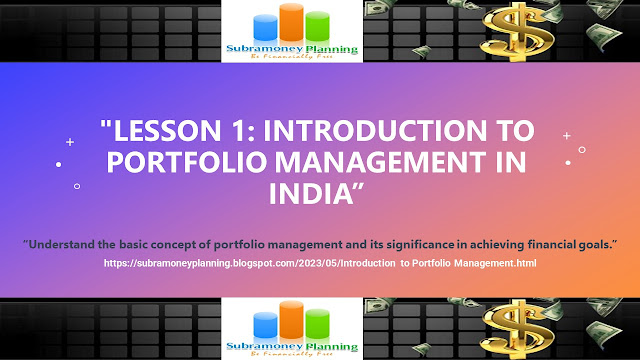Welcome to the first lesson of our 20-part blog series on portfolio management for beginners in India. In this lesson, we will provide you with a detailed introduction to portfolio management, its importance in the Indian context, key concepts, and the benefits it offers. Understanding the fundamentals of portfolio management will lay a strong foundation for your investment journey in India. So, let's dive in and explore the world of portfolio management!
 |
| Lesson 1: Introduction to Portfolio Management in India Subramoneyplanning |
Portfolio management is the art and science of managing a collection of investments, assets, or projects to achieve specific financial goals. In the Indian context, it involves making informed decisions regarding asset allocation, diversification, risk management, and ongoing monitoring and adjustment of the portfolio.
Scenarios and Examples:
Let's consider an example: You are an individual investor in India with a portfolio consisting of stocks, mutual funds, and fixed deposits. Portfolio management would involve evaluating the performance of each investment, rebalancing the allocation based on market conditions, and making informed decisions to achieve your financial objectives, such as wealth creation, retirement planning, or funding education.
Advantages:
• Diversification: Portfolio management allows for diversification across different asset classes in the Indian market, such as equity, debt, and commodities. This diversification reduces the risk associated with any single investment and helps protect your portfolio from market volatility.
• Risk Management: By carefully assessing and managing risks, portfolio management aims to minimize potential losses and protect your investments against market downturns or unexpected events.
• Goal Alignment: Portfolio management ensures that your investments align with your financial goals, taking into account factors specific to India, such as inflation rates, tax considerations, and economic trends. It helps you stay on track and work towards achieving your desired outcomes.
Disadvantages:
• Complexity: Portfolio management requires understanding investment strategies, market analysis, and monitoring. The complexity can be challenging for beginners in India without the necessary knowledge and expertise. It may require continuous learning and staying updated with market trends and regulations.
• Market Volatility: The Indian market is known for its volatility, and portfolio values may fluctuate. Investments may not always perform as expected due to economic, political, or other factors specific to India. It is important to have a long-term perspective and be prepared for market ups and downs.
Key Takeaways:
• Portfolio management involves managing a collection of investments to achieve specific financial goals in the Indian context.
• Diversification, risk management, and goal alignment are key advantages of portfolio management in India.
• Complexity and market volatility are potential challenges in portfolio management for beginners in India, emphasizing the need for continuous learning and long-term perspective.
Conclusion:
This introductory lesson has provided you with a comprehensive understanding of portfolio management in the Indian context, its purpose, advantages, and potential challenges. As you embark on your investment journey in India, remember that portfolio management is a continuous process that requires careful analysis, regular monitoring, and adjustment to align with your financial goals and risk tolerance. Take advantage of the opportunities provided by the Indian market while being mindful of the risks. In the next lesson, we will explore the crucial aspect of setting financial goals in the Indian context and how they shape your portfolio management strategy. Stay tuned for more valuable insights and practical tips on portfolio management for beginners in India.
Please refer Portfolio Management and its Objectives post for more clarifications and learnings.






0 comments:
Post a Comment